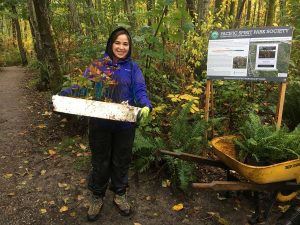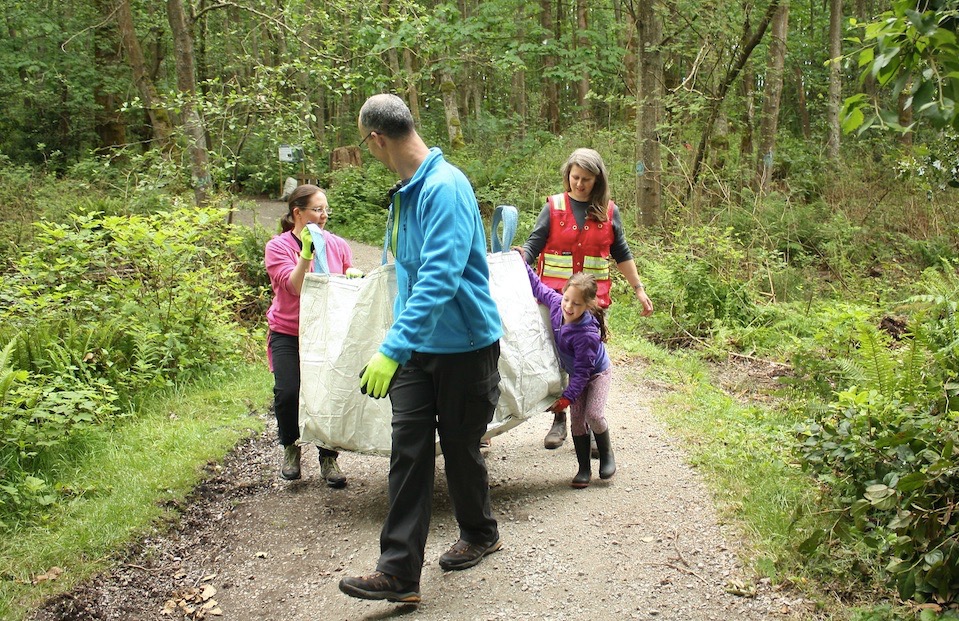Pacific Spirit Regional Park is a treasure for nature enthusiasts.
The park is a popular destination for campus residents and other visitors looking to connect with nature. In 2024, four million people visited the park, making it the busiest in the Metro Vancouver regional system.
There are 55 kilometres of trails in the park, but unless visitors know about identifying flora and fauna, they wouldn’t know that they are surrounded by many types of invasive species.
Invasives are often harmful to the environment, as they out-compete local species for resources and space, eventually leaving behind a place inhabitable to many native organisms, not just plants. Furthermore, they can be a direct risk to human wellbeing as they can threaten agriculture, public health, and tourism.
The prevalence of invasives is visible on a stretch of Sword Fern Trail – one of Pacific Spirit’s longest. It is here where a team of volunteers is working on a multiyear project to restore part of the park.
In the 1930s, parts of campus and the area around Sword Fern Trail was logged to generate revenue for the university, says Mike Jerowsky, President of the Pacific Spirit Park Society.
By 1943, logging ceased due to poor forestry management practices, leaving the land degraded. Developers started eyeing the area, and as time went on, pioneer species came through and died out, birds and wind brought seeds from far away, and gardeners introduced increasing numbers of non-native plants for their yards. As a result, what once was a thriving natural ecosystem became one plagued by invasive plant species.
In the meantime, local residents, environmentalists, and groups like the Endowment Lands Regional Committee pushed for preservation. “The Sword Fern Trail were spared from development as part of these broader conservation efforts,” says Jarowsky.
In 1973, despite political resistance and the push for development, parcels of land including Camosun Bog were set aside for protection. A further push by conservationists and other stakeholders would lead to the establishment of Pacific Spirit Regional Park in 1989.

It was a victory, but the task to undo some of the degradation would soon begin, and it continues to this day.
Since 2017, the Pacific Spirit Park Society’s volunteer EcoTeam has been working every week to restore parts of the park. “Since then we have focussed on this area for three total years, removing invasive species and planting native plant species while improving the conifer seed bank in the area,” said Jerowsky.
Currently, this team operates in an area along Sword Fern Trail, just north of University Chapel, on University Boulevard. The year is usually split between two primary tasks: planting native trees and removing invasive species.
Planting takes place during the fall, featuring trees such as Cedars, Douglas Fir, Hemlock, pines, and huckleberry shrubs.
The rest of the year is dedicated to removing invasive species, such as English Ivy, Laurel, English Holly, and Himalayan Blackberry.
It requires consistent work, and significant results will likely not show for at least a couple decades. That’s the nature of restoration work. Thus, goals are generally long-term and include monitoring and continued maintenance.
Should you start removing invasive species or planting natives as you walk the trails?
Not so fast, says Jerowsky. This kind of work needs to be coordinated with Metro Vancouver and ideally coordinated with a group like the Pacific Spirit Park Society.
“Removing invasive species without knowing the full impact on local ecosystems can sometimes have unintended consequences,” he said.
“Additionally, proper plant identification is essential, and these are skills that we can help teach interested community members if they want to come out to be part of our team.” Want to join in? Visit pacificspiritparksociety.org/volunteer-sign-up/ and volunteer your time to restore the natural beauty of this cherished park.
SIMON DING IS A CAMPUS RESIDENT WITH A BACHELORS IN PUBLIC HEALTH – GLOBAL HEALTH FROM THE UNIVERSITY OF WASHINGTON, AND MEMBER OF THE NEWSPAPER EDITORIAL COMMITTEE.
WITH ADDITIONAL REPORTING BY EMMANUEL SAMOGLOU.
